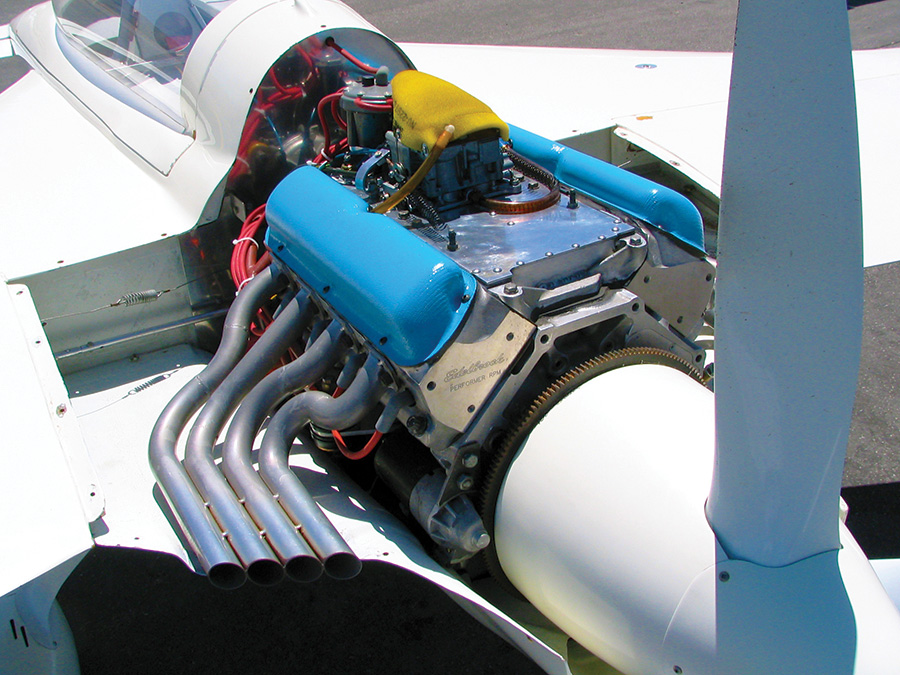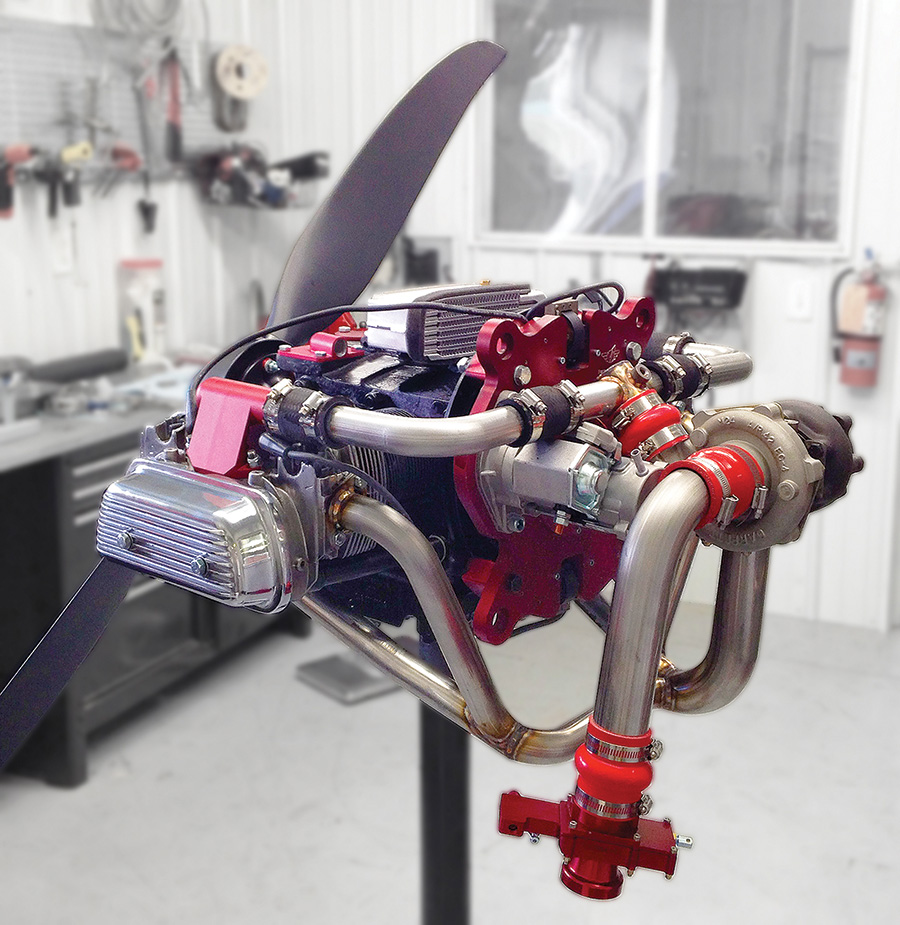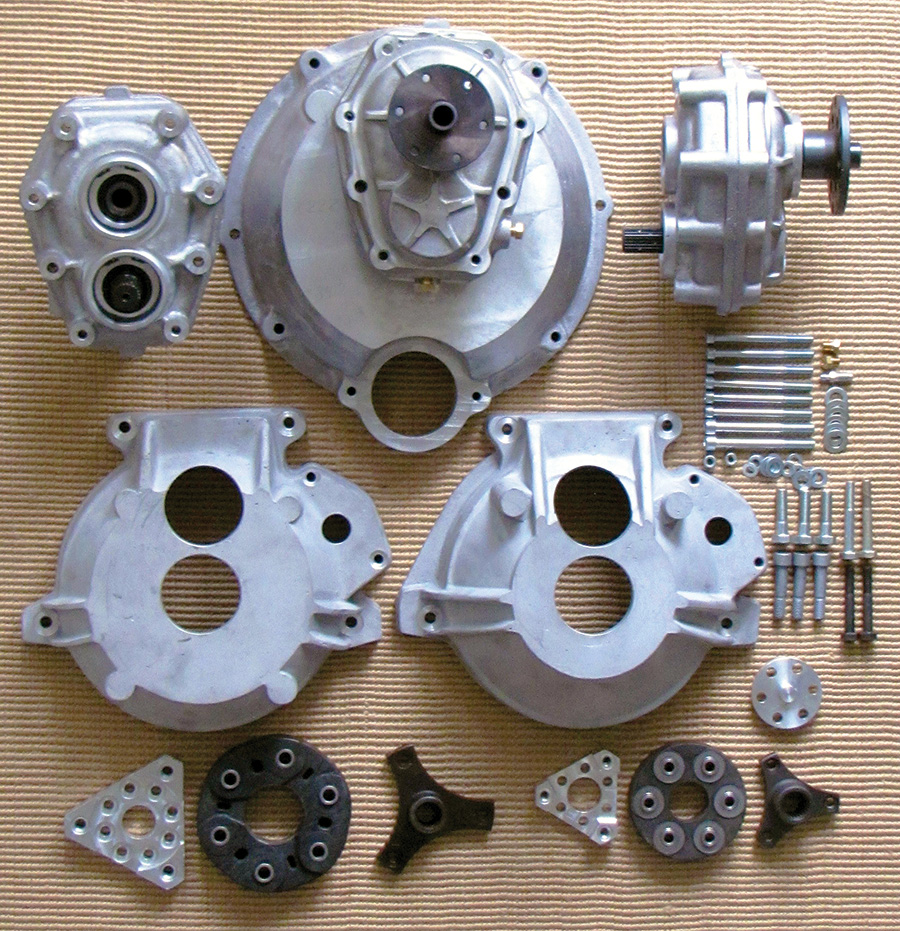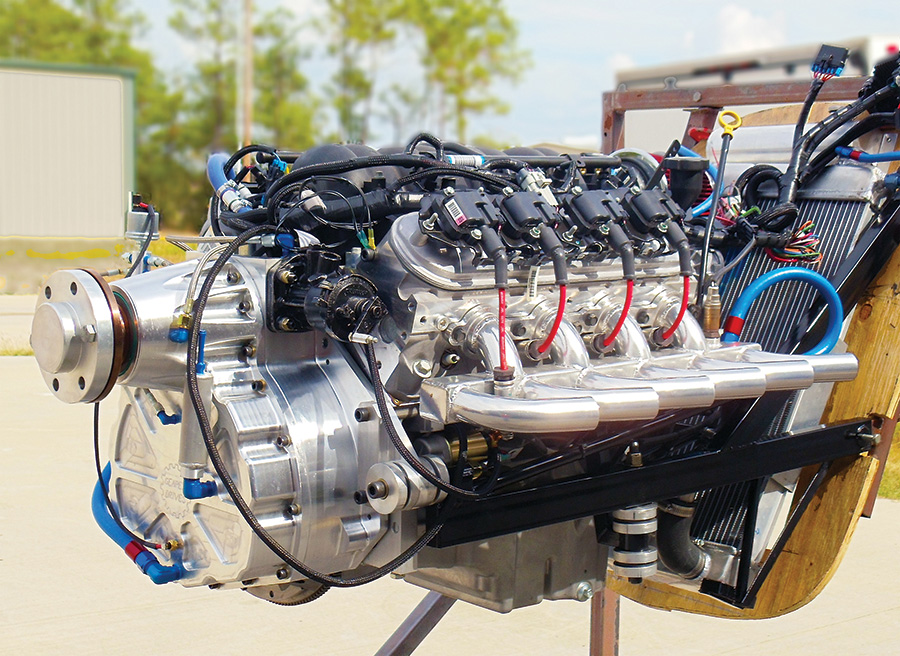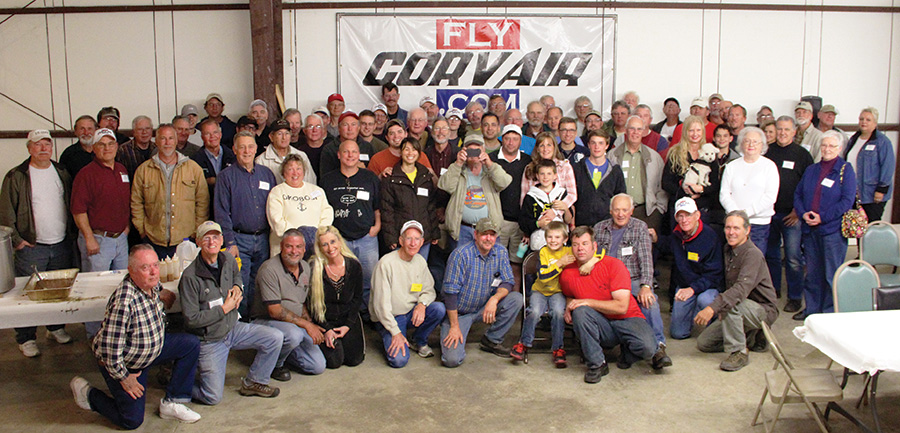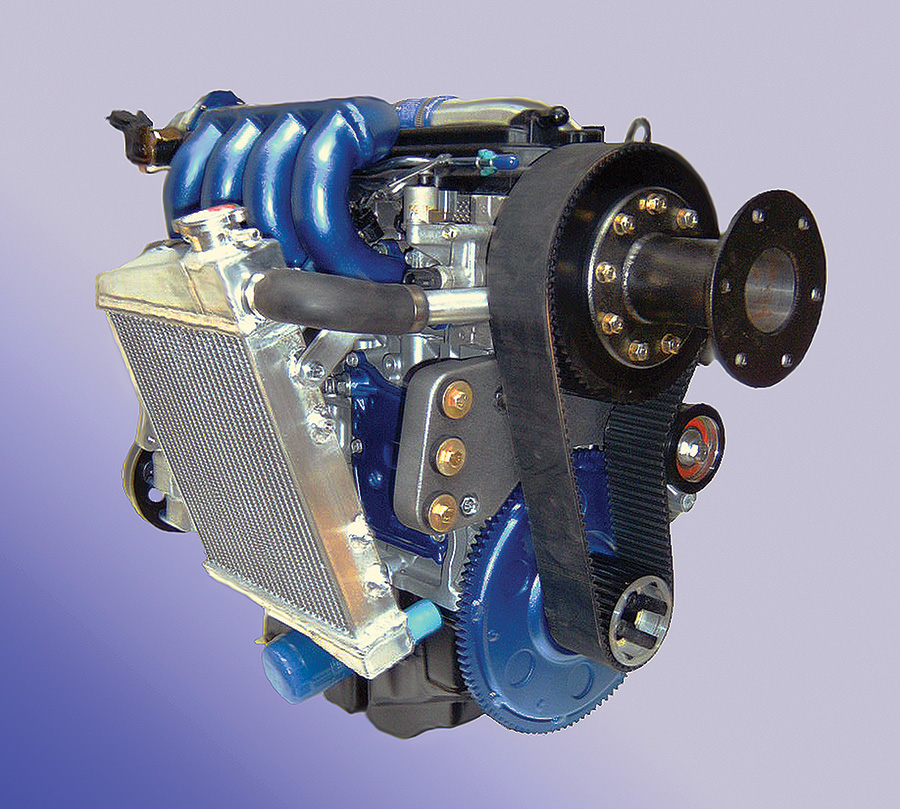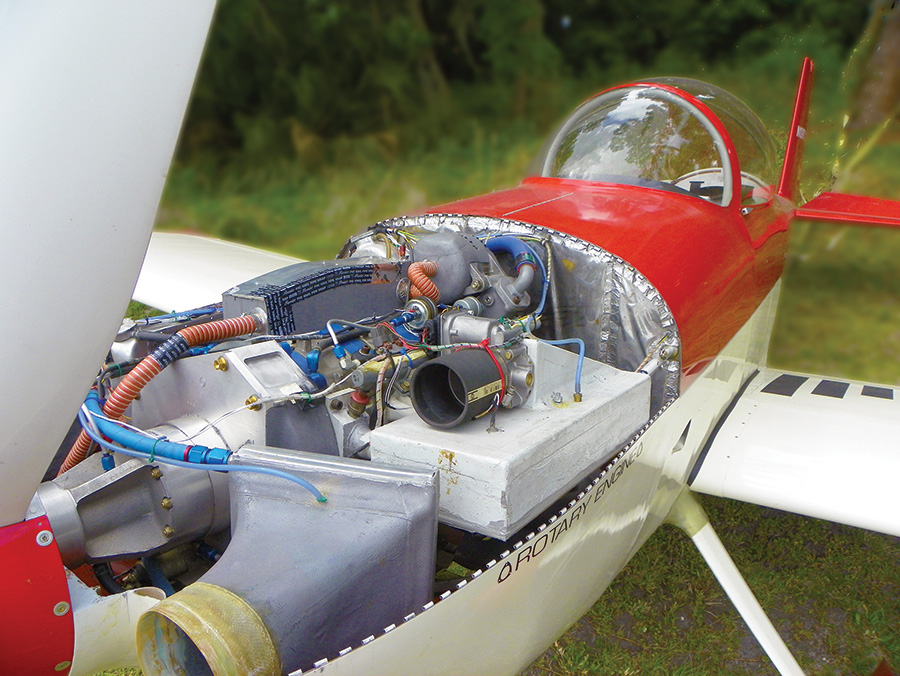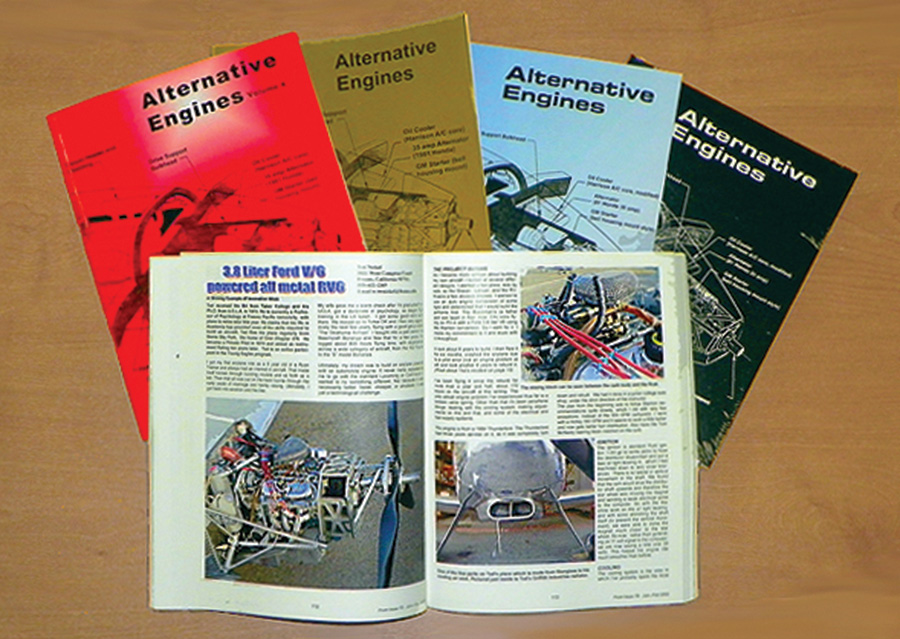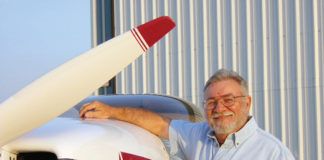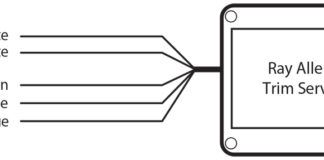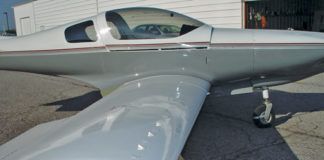This year’s Alternative Engine Buyer’s Guide is a little different than those before. In the past, the line dividing traditional powerplants from the alternatives was drawn by the certified engines. You don’t get more traditional than the familiar Continentals and Lycomings, along with their aftermarket clones.
A direct-drive, all-aluminum, small-block Ford engine nested in the engine compartment of a very fast and economical Long-EZ.
But the line was a little blurred when it came to those engines used in Light Sport Aircraft and ultralights. Jabiru, UL Power, and certainly some of the Rotax offerings, as well as other engines that were created from the beginning to be used as an aircraft engine (as opposed to those that were converted from another application to aircraft use), were easy to compile with the traditional engines. But there were some that simply fell through the cracks.
This year, we drew a hard line and have defined alternative engines as those that were not designed by the original manufacturer to be used in aircraft, but have been converted for that purpose. So with that, we lost a few engines from last year’s list.
As with last year’s guide, all of the major players (and a few of the minor ones) were contacted and asked, “What’s new?” While not everyone took the time to answer back, the results of those inquiries are presented here. Companies are listed in alphabetical order for simplicity’s sake. If anyone has inadvertently been overlooked, please let us know by emailing [email protected] so that we can include you next year and add you to the online version of this resource. Now let’s get started.
AeroConversions
AeroConversions is a product line of Sonex Aircraft, LLC. The company has made a number of changes to the turbocharged AeroVee VW conversion that has been flying in the Waiex prototype. A new intake manifold and exhaust allow the turbo AeroVee to be installed in all Sonex Aircraft configurations.
Early in 2013, Sonex developed and installed a new engine test cell in the Hornets’ Nest R&D Center at their home base in Oshkosh, WI. The test cell is used for engine development and endurance testing, and the first project to use the new test cell was the AeroVee Turbo prototype.
The move to the engine test cell allowed the R&D team to accomplish many experiments in a short period of time. Examples of these experiments include different levels of boost, oil inlet and exit restrictors, and gravity feed vs. secondary-pump fuel systems. They were also able to fully monitor and record engine CHTs, EGTs, and oil temperatures and pressures. The test cell features an MGL Avionics engine management system that records all critical data, which can then be downloaded and analyzed with every change.
The Hornets’ Nest R&D team is particularly encouraged by cylinder head and oil temperatures in this system. “We’ve run more than 50 individual experiments in the last six months by changing one or more components in the system,” commented Jeremy Monnett, company CEO. “Our goal is to reduce the weight of the components being used, while providing more power than our popular 80-hp AeroVee. Once we’re satisfied that the turbo configuration is dialed-in on the test cell, the engine will be moved back to a factory-owned Sonex for further flight test and refinement.”
Sonex intends to support a retrofit kit that will allow anyone with an existing AeroVee engine to be able to upgrade to the turbo system, if and when it becomes available for sale.
Sonex also revealed that Sensenich has developed a ground-adjustable propeller for the Sonex line of aircraft that can be used at the low-end of the pitch range with the standard 80-hp AeroVee and at the high-end of the pitch range with the turbo AeroVee installation.
Air Trikes Enterprises
Vassili Tarakanov is the owner and operator of Air Trikes Enterprises, founded in Canada in 2001. An aerospace engineer, Vassili “walks the walk” as he builds, designs, and flies hang gliders and trikes, and has been doing so since 1983. Vassili has also come up with engine conversion components for converting Geo/Suzuki and Subaru engines, as well as several others. Air Trikes Enterprises offers component kits (gearboxes, propellers, mufflers, engine mounts, etc.), complete running engines, and individual components for a wide range of Experimental aircraft.
Air Trikes 160 and 280 gearbox conversion kits are designed for engines up to 280 hp, including, but not limited to, the six-cylinder, horizontally-opposed Subaru.
Auto PSRU’s (Formerly Geared Drives)
During the past year at Auto PSRU’s, Stuart Davis has been busy incorporating many new features into the evolution of the 200Z (Subaru) and BW350 (Chevy V8) propeller speed reduction units. Both gearboxes now have dipsticks to easily check the lubricant levels, magnetic drain plugs to check for foreign material (even though it still has an oil filter), and new shaft seal retainers. The BW350 also has a new pressure plate and flywheel design that has been successfully tested to 6000+ rpm. It’s also available to current customers as a retrofit.
The BW350 lubrication system has gone through a comprehensive battery of tests to resolve foaming, filtration issues, the use of synthetic lubricants, and improved propeller governor response. Other internal refinements are being reviewed as well.
Auto PSRU’s BW350 firewall-forward installation on an FEW P-51. The PSRU fits Chevrolet LS Series Engines, all 4-, 6-, and 8-cylinder Chevrolets built since 1955, Ford 302 and 351 Windsor as well as V-12 BMW, and can be adapted to virtually any engine in the 200-400 HP range.
In addition, a new engine control unit, an air induction system, and a wiring harness are being developed for LS3 firewall-forward installations with improved performance to replace the out-of-production Chevrolet LS1 engine.
The 200Z PSRU for Subaru engines went back into production in September 2013, with the BW350 returning in December 2013. In 2014, the 200Z will be adapted for use with Mazda rotary engines, since it has zero offset.
FlyCorvair.com
After 25 years of working with Corvair flight engines, and over 15 years actively selling his Corvair engine conversion manual and various conversion parts, to say that the Wynne Corvair engine conversion is a mature product is an understatement. But what Corvair expert William Wynne really brings to the table is his openness to share information and his willingness to help others build a safe, economical, and reliable powerplant for their homebuilt aircraft. One way he does this is through his “Corvair College,” where he offers hands-on tutelage to numerous individuals who are in the process of converting a 1960s Chevrolet Corvair engine for use in an Experimental aircraft. Traditionally a semiannual event conducted at various locations throughout the country, Wynne is increasing his schedule to four “Corvair Colleges” during 2014.
“These are free, hands-on events where builders assemble and run their own Corvair engines with our instruction, tools and test equipment,” said Wynne. “This year’s Colleges, numbers 28 through 31, will be held in Texas, Florida, Missouri, and South Carolina. Our web site (www.flycorvair.com) has the dates and registration information.” Wynne invites builders interested in the traditional Experimental aviation goals of “learn, build, and fly” to join him and his crew of knowledgeable and friendly volunteers.
The Wynne Corvair conversion’s success is based on careful development and evolution, starting back when Bernard Pietenpol first flew the Corvair in his legendary Pietenpol Air Camper in the 1960s. Its direct-drive, horizontally-opposed, air-cooled configuration continues to appeal to builders who are seeking a simple, reliable powerplant, operating at just 60% of its maximum automotive power and rpm ratings.
To find out more about the Corvair, look for William Wynne’s speaking schedule at Sun ‘n Fun in Lakeland Florida, or EAA AirVenture in Oshkosh, Wisconsin.
HaasPowerAir
With over 500 hours on the prototype and performance as designed, Ben Haas of HaasPowerAir is ready to take the next step by offering firewall-forward kits of his small-block Ford engine and PSRU combination. Ben’s initial target market is the RV-10, Murphy Moose, Lancair, Velocity, and any other Experimental aircraft needing a quality powerplant in the 200–400 hp range. HaasPowerAir is also capable of fabricating parts for custom, one-off projects.
Raven ReDrives
Raven ReDrives, Inc. is now in its 19th year of producing reduction drive kits and complete engine packages. For 2014, the company is introducing a naturally-aspirated, 115-hp version of the 1.5-liter Honda Jazz/Fit engine. A 140-hp turbocharged version of the engine is also available.
According to company president, Jeron Smith, the 115/140-hp engine package was designed specifically for the Zenair 650/750 and Raven’s own “Super-STOL” cargo aircraft.
Raven also offers a line of redrives based around 1.0- and 1.3-liter Geo Metro/Suzuki engines. These power-plants produce 58 to 115+ horsepower and were designed for aircraft that might otherwise be powered by much more expensive Rotax 503, 582, 912, 912S and 914 engines.
Revmaster Aviation
The new Revmaster R-2300 (2331cc) engine builds upon Revmaster’s proprietary systems and parts, including its RM-049 heads that feature large fins and a hemispherical combustion chamber. It maintains the earlier R-2200 engine’s top horsepower (82) at 2950 rpm continuous. (Takeoff power is rated at 85 hp at 3350 rpm.) The additional power ultimately comes from a bore of 94mm, lengthening of the R-2200’s connecting rods, plus increasing the stroke from 78 to 84mm, but that is oversimplifying things.
The longer stroke results in more displacement, and longer connecting rods yield better vibration and power characteristics. The lower cruise rpm allows the use of longer propellers—and the higher peak horsepower results in shorter takeoffs and steeper climbs.
The Revmaster’s four-main-bearing crankshaft runs on a huge 60mm center main bearing and is forged from 4340 steel with nitrided journals. Thrust is handled by the 55mm #3 bearing at the propeller end of the crank. Fully utilizing its robust #4 main bearing, the Revmaster crank has built-in oil-controlled propeller capability, a feature unique in this horsepower range.
The direct-drive R-2300 retains Revmaster’s famous dual CDI ignition with 8-coil spark to 8 spark plugs, dual 20-amp alternators, oil cooler, and proprietary Rev-Flo carburetor.
Revmaster’s 85hp R-2300 powers the Thatcher CX5 prototype. Now in Phase 1 testing, the CX5 was designed for this engine.
| Company | Engine Category | Product | Direct Drive | RD or PSRU | Air-cooled | Liquid-cooled | HP Range |
| AeroConversions | Volkswagen | FWF 4-cylinder opposed Kits | ✔ | ✔ | 80 | ||
| Air Trikes | Geo/Suzuki, Honda Fit BMW, Subaru | FWF, 2-4 cylinder, inline and opposed, PSRU and propellers | ✔ | ✔ | 60 to 280 | ||
| Atkins Rotary | Rotary | Engine only kits and running, rebuild supplies | ✔ | 180+ | |||
| Auto PSRUs (formerly Geared Drives) | General Motors, Subaru | FWF, 4-, 6-, 8-cylinder, V8, inline 4, horizontal 4 and 6, PSRU | ✔ | ✔ | 150 to 400 | ||
| Autoflight | Subaru and others | PSRU for EA and EJ Subaru engines plus universal | ✔ | up to 160 | |||
| EPI Inc. | General Motors, Ford, Jaguar, new “clean sheet” EPI V12 | Custom V-8 and V-12 engines and installations, PSRU | ✔ | ✔ | 250 to 1600 | ||
| FlyCorvair.com | Corvair | FWF 6-cylinder opposed kits and running | ✔ | ✔ | 100 to 120 | ||
| Firewall Forward | Honda VTEC, GM | FWF 4 cylinder, V8 PSRU | ✔ | ✔ | 100 to 500 | ||
| Great Plains Aircraft Supply | Volkswagen | FWF 4-cylinder opposed kits and running | ✔ | ✔ | ✔ | 50 to 103 | |
| HaasPowerAir | Ford | FWF aluminum V8, PSRU | ✔ | ✔ | 200 to 600 | ||
| Hummel Engines | Volkswagen | FWF 2- and 4-cylinder opposed kits and running | ✔ | ✔ | 28 to 85 | ||
| Moteur Avance Mega, Inc. (Marcotte) | Subaru and Others | FWF engines of various types, including Mazda, Subaru and V-8 | ✔ | ✔ | ✔ | ✔ | 75 to 600 |
| RAM Performance | Subaru | FWF 4- and 6-cylinder opposed, PSRU | ✔ | ✔ | 115 to 300 | ||
| Raven ReDrives Inc. | Suzuki, Geo, Honda | FWF 3- and 4-cylinder Inline, PSRU | ✔ | ✔ | 60 to 140 | ||
| Revmaster Aviation | Volkswagen | FWF 4-cylinder opposed, kits and running engines, engine mounts, 2330cc – 3000cc | ✔ | ✔ | 85 to 110 | ||
| Robinson V-8 Powered Aircraft | General Motors | FWF 8-cylinder V-8 running engines | ✔ | ✔ | 300 to 425 | ||
| Take Off GmbH | Bayerische Motoren Werke AG (BMW) | FWF 2-cylinder, opposed | ✔ | ✔ | 90 to 115 | ||
| Stratus 2000 | Subaru | FWF 4-cylinder opposed kits and running | ✔ | ✔ | 105 | ||
| Titan Aircraft | Suzuki and Honda | FWF 6-cylinder V-6 | ✔ | ✔ | 165 to 183 | ||
| Valley Engineering | V-Twin “Big Twin” Volkswagen | FWF cylinder V-twin kits and running, PSRU, Propellers | ✔ | ✔ | ✔ | 40 to 48 | |
| Viking Aircraft Engine | Honda Fit | FWF 4-cylinder inline | ✔ | ✔ | 110 |
FWF= Firewall forward
PSRU= Propeller speed reduction unit
RD= Redrive

